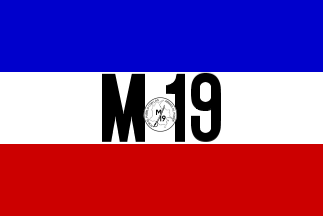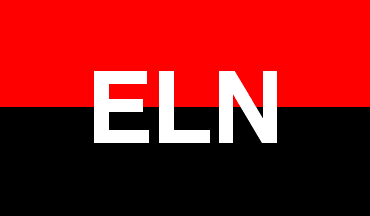
image by E.R., 23 March 2005

Last modified: 2006-06-09 by dov gutterman
Keywords: colombia |
Links: FOTW homepage |
search |
disclaimer and copyright |
write us |
mirrors
Editorial Remark: It must be noted that all the opinions are of the authors and not of FOTW. Our site is non-political and concentrates only on vexillological issues.
See also:
PDI (Polo Democrático Independiente, or Independent
Democratic Pole): A broad coalition of leftist movements, it is a
legal democratic party in Colombia. Its official website is <www.polodemocratico.net>.
E.R., 23 March 2005
An armed illegal group created in 1992 was called "Los
Pepes" (Pepes stands for PErseguidos por Pablo Escobar, or
Persecuted by Pablo Escobar). This was a mixture between
Escobar's former Medellin Cartel associates and Cali Cartel
rivals, who, after Pablo Escobar was interned in La Catedral
prison in 1992, he (Escobar) started to murder his closest
Medellin Cartel associates. Thus, this anti-Escobar alliance
proved helpful for Colombian authorities when this organization
started to hunt his lawyers, Escobar's relatives, associates,
hideouts, properties, bodyguards, and tip the Colombian legal
authorities with valuable information. Los Pepes disbanded later
in 1993, but this was somehow the main core out of which the
current AUC (right wing armed illegal organization) emerged.
Source: photo at SEMANA
magazine - November 30th, 1998 (caption of the photo
(translation): When Los Pepes came out in the open we applauded
them. We almost issued t-shirts saying 'we support Los Pepes' -
Words by Mr. Joe Toft (Director DEA Colombia back then).
E.R., 16 June 2005

based on Encyclopaedia Universalis
image by Ivan Sache, 10 December 1998

based on photo at SEMANA Magazine
image by Eugene Ipavec and Ivan Sache, 28
August 2005

based on photo (see below)
image by Eugene Ipavec and Ivan Sache, 28
August 2005
.gif)
logo
image by Eugene Ipavec, 28 August 2005
Vertically divided blue/white/red, with M-19 in black in the
white stripe.
Source: Photography of the funerals of the murdered
past-leader of M-19 Carlos Pizarro, flag over the coffin.
(Encyclopaedia Universalis, Yearbook 1991, p. 40).
Ivan Sache, 10 December 1998
According to Courrier International #711,
17 June 2004, M19 is the 19 April Movement, founded on 19 April
1970, mostly by students. The M19 entered the armed struggle
against the Columbian government in 1973. On 6 November 1985, the
M19 seized the Court of Justice in Bogota. The seizure ended in a
bloodbath when the tanks of the Columbian army attacked the
Court. In 1989, the M19 abandoned the armed struggle and joined
the political legal life. His leader was murdered when candidate
to the Presidential election in 1990.
Ivan Sache, 27 December 2004
Here is a photo of
Additional flag (variant with a logo showing a map of Colombia
with the sword of Colombia's liberator Simon Bolivar and with the
motto "Por el pueblo con las / armas al poder" (For the
people with the / arms to power). Also here is a photo from SEMANA
Magazine of a variant with different letter styles.
E.R., 23 March and 17 June 2005
Information taken from <www.country-data.com>:
"The 19th of April Movement (Movimiento 19 de Abril--M-19)
traces its origins to the allegedly fraudulent presidential
elections of April 19, 1970, in which the populist party of
former military dictator Rojas Pinilla, the National Popular
Alliance (Alianza Nacional Popular--Anapo), was denied an
electoral victory (see Opposition to the National Front , ch. 1).
Although Anapo--which was subsequently led by Rojas Pinilla's
daughter, María Eugenia Rojas de Moreno Díaz, following the
dictator's death in 1975--denied all links with the M-19, the
organization proclaimed itself to be the armed branch of the
party. During the early 1970s, Carlos Toledo Plata and Jaime
Bateman Cayón distinguished themselves as the M-19's principal
leaders and ideologues. Toledo, a physician, was an Anapo
representative in Congress. Bateman served as the M-19's
principal commander for military operations. Both these men died
during the 1980s--Toledo in a shooting by two men believed linked
to the MAS and Bateman in an airplane crash. By mid-1988 Carlos
Pizarro León-Gómez had emerged as one of the group's principal
decision makers.
The M-19's ideological orientation was a mixture of populism and
nationalistic revolutionary socialism. This orientation often led
the group to seek political support from Nicaragua and Cuba, but
the M-19's leadership also claimed that it resisted forming
permanent foreign ties.
By mid-1985, when the number of active members was estimated at
between 1,500 and 2,000, the M-19 had become the second largest
guerrilla group in Colombia. According to the IISS, the size of
the M-19 in 1987 was estimated at 1,500 militants. A member of
the Barco administration who was in charge of the government's
peace efforts, however, calculated that the organization had only
500 armed militants nationwide. By the mid-1980s, the M-19 had
eclipsed all other guerrilla organizations in urban operations.
The M-19 reportedly established columns (units) in each of
Colombia's major cities. These columns were in turn organized
into independent cells.
Although the M-19's early operations, begun in 1972, were limited
to bank robberies, it quickly gained national attention through
the 1974 theft of Simón Bolívar's sword and spurs from the
exhibit in the liberator's villa. Two years later, the group
kidnapped and subsequently murdered a Colombian trade union
official the M-19 accused of having ties to the United States
Central Intelligence Agency. In 1977 the M-19 began a campaign of
economic sabotage. The following year, government offices and
police stations became the targets of numerous attacks. In
addition, the offices and representatives of United States-based
multinational corporations were repeatedly targeted in an effort
to drive the foreign interests from the country. Kidnappings of
prominent individuals continued, some of which resulted in the
deaths of the abductees. In 1980 the seizure and occupation, for
sixty-one days, of the Dominican Republic's Bogotá embassy
gained the group international attention.
The M-19's increasingly bold activities, coupled with evidence of
Cuban training and logistical support, prompted a hardening in
the policies of the Turbay administration during its final year
in office. In 1982, however, the newly installed Betancur
administration offered political amnesty in exchange for the
M-19's agreement to a cease-fire. In July 1984, government
officials and guerrilla leaders signed a cease-fire agreement at
Corinto in Cauca Department.
By late 1985, however, the accord unraveled. Charging the
government with, among other things, a systematic violation of
the truce provisions and failure to implement key political
reforms that were part of the cease-fire agreement, the M-19
returned to armed struggle. In October 1985, guerrillas wounded
then-Commanding General of the Army Samudio. By far the most
spectacular operation of the M-19 came the following month, when
commandos seized the Palace of Justice in Bogotá. The ensuing
battle between the M-19 and the military left over 100 dead,
including 11 Supreme Court judges (see Interest Groups , ch. 4).
After the Palace of Justice operation, the M-19 reduced its
activities, leading some analysts to surmise that its membership
base had declined. In early 1986, the M-19 reportedly attempted
to establish a common guerrilla front with members of Peru's
Shining Path (Sendero Luminoso) and Tupac Amaru Revolutionary
Movement (Movimiento Revolucionario Tupac Amaru) and with
Ecuador's Alfaro Lives, Damn It! (¡Alfaro Vive, Carajo!) group.
The March 1987 killing of Alvaro Fayad, the M-19's top political
and military strategist, was believed to have dealt the
organization a severe setback, however.
In May 1988, the M-19 again burst into public prominence by
kidnapping Alvaro Gómez Hurtado, a two-time presidential
candidate and Conservative Party leader. Gómez Hurtado's release
was obtained two months later in exchange for the government's
agreement to meet with M-19 leaders at the papal nunciature in
Bogotá. The meeting was to have paved the way for a national
summit to include representatives of the country's principal
guerrilla groups. Barco subsequently announced, however, that he
would not send an official representative to the preliminary
peace talks." (Data as of December 1988).
from <www.tkb.org>:
"Current Goals: The M-19 essentially ceased to exist in
1990. M-19, under intense pressure from the Colombian
government's security forces, as well as right-leaning
paramilitary groups, agreed to a ceasefire and shortly after laid
down its arms permanently to become the Colombian political
party, Democratic Alliance M-19. Predictably, some members
rejected the cease fire, formed new terrorist groups, and
continue to wreak violence and death throughout Colombia.
E.R., 8 May 2005
![[M19 Guerilla Movement (Colombia)]](../images/c/co}adm19.gif)
image by Jaume Ollé, 23 March 2005
Here is the flag of the former leftist group when it laid down
arms. The group transformed into the AD M-19 (Alianza
Democrática M-19, or Democratic Alliance M-19).
E.R., 23 March 2005

image by Santiago Tazon, 2 September 2000
Thousands of workers and students marched on the US embassy
and other places in Bogota and Cartagena de Indias, protesting
because Clinton's visit. They fly several red vertical flags of
MOIR (Movimiento Obrero Independiente y Revolucionario) -
Independent Revolutionary Workers Movement. MOIR is a Colombian
political (communist) party.
Santiago Tazon, 2 September 2000
![[M19 Guerilla Movement (Colombia)]](../images/c/co}mcu.gif)
image by Eugene Ipavec, 13 December 2005
There was an illegal organization in Colombia known as
"El Cartel de Medellín" (Medellin Cartel). It was also
known in its beginings as "Los Extraditables". However,
this was some kind of umbrella organization that participated in
many illegal activities such as narcotics, assassinations,
bribery, racketeering, terrorism, "dirty politics"
(corruption, etc.). This flag was used by a political movement
called "Movimiento Civismo Unido" also known as
"Movimiento Civismo en Marcha". This was a
liberal-oriented political party headed by drug lord Pablo Emilio
Escobar Gaviria (a.k.a. El Patrón, a.k.a. El Señor) which
started in the outskirts of Medellin to erradicate poverty, build
soccer fields and build houses as well (most of this through
money laundering derived from narcotics trafficking) and it was
his political platform to run for Congress as Member of the House
of Representatives (lower chamber). He actually was elected as
the second Representative of Jairo Ortega (another liberal) for
the Department of Antioquia. So when Ortega was absent Escobar
took his place in Congress (shortly afterwards his ties with
drugs escalated a war that had already started and he was forced
to step down and the manhunt began...). This episode became what
is known as Colombia's Drug War (1984-onwards) although drug
trafficking had been around since the 1970's. Pablo Escobar was
shot dead on December 2nd, 1993 on a raid by the Colombian
Police, by Colonel (then Mayor) Hugo Heliodoro Aguilar Naranjo
(now the Governor of the Department of Santander), who led the
final assault on Escobar's safehouse in Medellin. The image is a
snapshot of the documentary "Los Archivos Secretos de Pablo
Escobar" (Pablo Escobar's Secret Files) by Marc Beaufort,
released on February 13, 2004, produced by Centauro Films, with
the help of Escobar's family and close relatives. There is a
little insight on the documentary which can be found at <www.elcolombiano.com>.
The flag itself is divided into three equal horizontal stripes
and the colors are green (top), white (middle) and red (bottom).
In the middle it has a red disc (very similar to the Japanese
flag) and also three flags (one green with a white tree and
another green flag with a book, the third flag being white with a
red heart on it.
E.R., 7 June 2005 and 30 November 2005
The three depicted flags seems to be:
- Black flag with white open book centered
- White flag with red stylized heart (like the playing card suit
"hearts") centered
- Black flag with white tree at the fly.
Probably flagoids standing for some "virtue" each.
Perhaps education, peace, and environment?
António Martins-Tuválkin, 18 December 2005
Actually the name is Movimiento Civismo en Marcha, as I
verified today searching the web.
Source: Semi official website of the
Documentary "Los Archivos Secretos de Pablo Escobar".
E.R., 4 June 2006
This is the review on the (CNG - CGSB) taken from <www.tkb.org>:
"Mothertongue Name: Coordinadora Guerrillera Simón Bolívar
(CGSB). Base of Operation: Colombia.
Founding Philosophy: In the 1980s, several leftist terrorist
organizations in Colombia created an umbrella organization, from
which to coordinate negotiations with the Colombian government
and to coordinate certain terrorist activities. The National
Guerrilla Coordinating Board (CNG), formed in 1985, was the
forerunner to a broader coordinating board. In 1987, CNG was
reconstituted as the Simon Bolivar Coordinating Board (CGSB).
CGSB was created as a unified front for the
terrorist-organization members. While CGSB engaged the government
in negotiations, the terrorist members simultaneously held onto
their rebel-controlled areas and remained willing, at varying
levels, to commit terrorist attacks. The Simon Bolivar
Coordinating Board was comprised of Revolutionary Armed Forces of
Colombia (FARC), April 19 Movement (M-19), National Liberation
Army (ELN), Popular Liberation Army (EPL), Workers' Revolutionary
Party (PRT) and the Quintin Lame Command.
CGSB participated in a series of government talks in the early
1990s. The talks were jeopardized several times by terrorist
attacks of the FARC and ELN. Despite the continuing aggression of
the two largest terrorist groups, CGSB did achieve limited
success. Resulting from government negotiations, M-19 put down
its arms in 1990. EPL's main body followed step, ceasing its
operations in 1991. However, Colombia's largest leftist terrorist
organizations, FARC and ELN, did not reach a settlement with the
government and continue terrorist operations to this day. In
fact, while some groups seriously negotiated for an end to
hostilities, other elements of the CGSB continued to perpetrate
terrorist attacks, claiming attacks both under the umbrella of
CGSB and as individual terrorist groups.
Current Goals: The Simon Bolivar Coordinating Board (CGSB)
disbanded in the early 1990s. While certain CGSB factions ceased
terrorist operations in the early 1990s, the FARC and ELN remain
significant terrorist organizations".
E.R., 23 March 2005

image by Ivan Sache, 23 Febuary 2002
The flag of Ejercito de Liberacion Nacional is at <www.eln-voces.com>.
The flag and emblem of ELN is explained by the organization in
this site.
Dov Gutterman, 8 March 1999 and Jaume Olle', 19
April 2001
From <www.tkb.org>:
Mothertongue Name: Ejercito de Liberacion Nacional (ELN). Base of
Operation: Colombia.
Founding Philosophy: The ELN is a Cuban Revolution-inspired
group, heavily influenced by the early actions and theories of
Fidel Castro and Che Guevara. The ELN emerged following the
overthrow of the Cuban government by Guevara and Castro in 1959.
The National Liberation Army was founded by two distinct groups.
The first group comprised of urban, left-wing intellectuals with
strong ties to rural farmers. They co-founded the group with a
radicalized group of oil sector unionists from Barrancabermeja's
oil industry. Radical members of the Catholic clergy joined the
group in late 1965. This was the first time that Christians and
Marxists had joined together in a Colombian revolutionary
movement. The ELN's unique founding philosophy strongly
emphasized socialism, mixing Castro-ism with the liberation
theology of the Catholic Church. More concretely, the ELN's
self-appointed role was to represent the rural poor and decrease
the foreign presence in Colombia. The ELN's goal was to take
power from the Colombian government and replace it with a more
egalitarian "popular democracy" that would represent
all Colombians equally under the law. The ELN strongly opposed
foreign investment, in part due to its location in an oil-rich
area and its connections to trade unionists in the energy sector.
The Colombian Department of Administrative Security estimates
that in 1998 alone, the ELN obtained U.S. $84 million from
ransoms and U.S.$255 million from extortion. Employees of oil
companies constitute a large percentage of the ELN's targets. The
kidnapping and extortion of oil company employees is ELN's
primary source of income. This is a natural legacy of ELN's
formation in an area rich with oil wells and oil companies. A
third, more recent source of income is the collection of a
"property" tax from coca and poppy cultivators. It is
not known whether the collection of property taxes is a
centralized or decentralized activity.
Current Goals: Throughout its history, the National Liberation
Army steadily gravitated towards violence and armed struggle as a
means to attain a socialist Colombia. At the ELN's 1996 national
conference, the group decided to decrease emphasis on creating a
purely socialist Colombia. Instead, the ELN has returned to its
founding objective: popular democracy for all Colombians,
propagated at the local level. The ELN has not given up the use
of violence in its efforts.
E.R., 23 March 2005
I found another version
of the ELN's flag at <www.ejercito.mil.co>.
The ELN uses sometimes their Coat
of Arms on their red/black flag,
E.R., 8 and 16 June 2005
The National Liberation Army- Camilista Union, (ELN-UC),
insurgent group in Colombia, uses also Black & Red flag and
generally, with the abbreviations of the group on the division of
the stripes in yellow letters. Given the bonds of ELN with Cuba,
it's possible that the ELN's flag is based fundamentally on the
one of "July 26' Movement".
Carlos Thompson, 30 September 2004